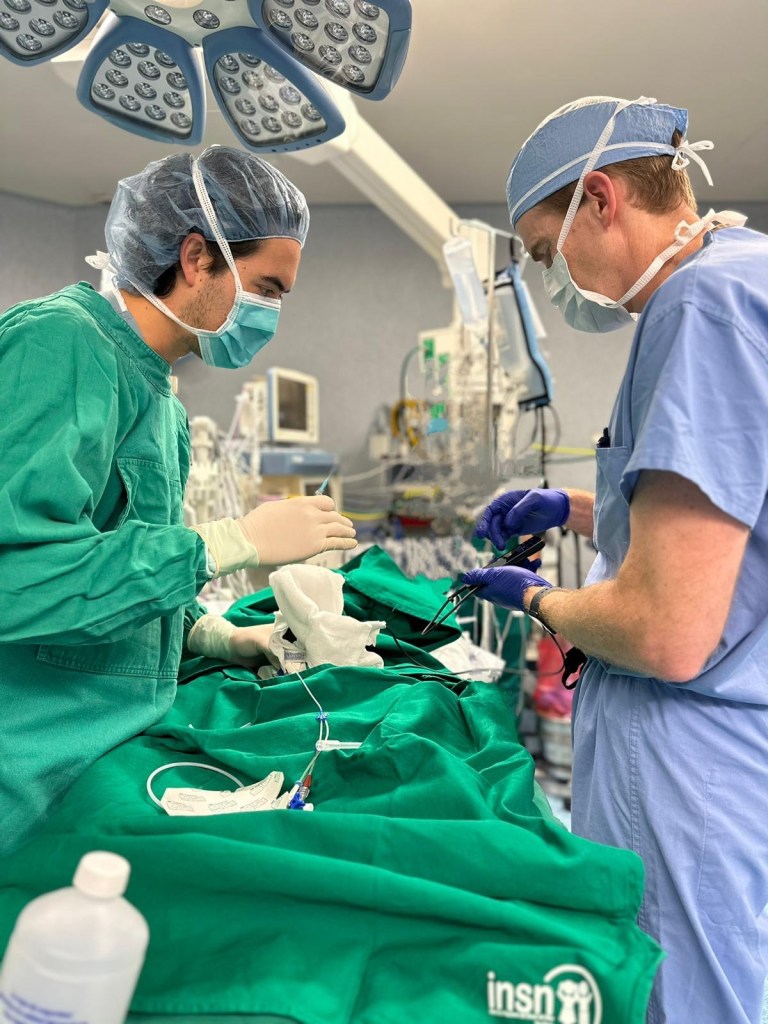
Small teams of UAB Medicine cardiologists, surgeons, anesthesiologists, perfusionists, and nurses are making a positive difference in South America, where they volunteer to share their expertise in complex pediatric heart disease and defects with local doctors.
The trips are organized by Heart Care International, a nonprofit group that partners with hospitals in developing countries to provide surgical cardiac care to children and teenagers and help those facilities develop their pediatric cardiology practices. For over a decade, UAB Medicine Chief of Pediatric Cardiac Surgery Robert Dabal, M.D., and Chief of Pediatric Cardiothoracic Anesthesia Jack Crawford, M.D., have led UAB Medicine teams to participate in the group’s medical outreach programs.
In November 2023, those UAB Medicine leaders invited new colleague Patrick Hussey, M.D., to follow in their footsteps at a major hospital in San Borja, Peru, just outside the capital city of Lima. A cardiac anesthesiologist in the UAB Department of Anesthesiology and Perioperative Medicine, Dr. Hussey helped the San Borja hospital update its pediatric cardiology practice. The work immediately benefitted numerous children and will help many more in the future thanks to the care-planning, technological, and pharmacological insights he and his team shared during their weeklong visit.
“I didn’t have any hesitation in accepting the invitation, and it was an honor to be invited,” Dr. Hussey said. “It is a noble cause and for me was also a fascinating opportunity to work with different teams and across cultures.”
Practicing in Peru
Peru is a middle-income country, though nearly one-third of its population lives in poverty, Dr. Hussey says. “The fact that our team could make meaningful progress in just a week depended on modern medical infrastructure and cardiologists set on improving their pediatric subspecialty work,” he said. “We were helping in a targeted way to address their use of technology, drug selection, and team-based case management, with the goal of helping them have a self-sufficient practice.”
The UAB Medicine and Children’s of Alabama pediatric cardiology team of five arrived after another group of U.S. doctors completed pre-operative assessments on specially selected cases. “They were looking to have us work these cases as an interdisciplinary team of about 20 people,” Dr. Hussey said. “They wanted to see how our surgeons approached each case, which techniques were chosen, and how we manage perfusion during surgery.”
Cardiac anesthesiology can be technical, behind-the-scenes work. But in Peru, Dr. Hussey saw firsthand how many lives he could impact. “I’ve never seen anything like the number of extended families that showed up for every inpatient child there,” he said. “Part of it was just how many more family they allow at the bedside, but it was immediately apparent that there was so much love and concern. To think we could help with conditions that might have become dangerous that very day was really inspiring.”
A critical case with limited time
The most critical of the 13 cases the team worked on was an arterial switch procedure for a newborn. The infant was born with a life-threatening heart defect that caused the two “great arteries” in the heart to be connected to the wrong sides of the heart. The arterial switch procedure corrects those crisscrossed connections.
Many infants are not developmentally ready for this complex surgery. Normally they would be given a drug called prostaglandin to maintain a connection between the two sides of the heart until their organs could grow to a size that makes the arterial switch safer. “But there was no prostaglandin left in Peru – period,” Dr. Hussey said, adding that the team had only a few days to decide what to do. “In the States, we use prostaglandin and talk over the next step for weeks rather than days or hours.”
The team of cardiologists, surgeons, and anesthesiologists discussed the situation with the local doctors for hours before deciding against surgery. Instead, they opted for a balloon atrial septostomy – a lower-risk procedure that uses a balloon to keep open the connection between the two sides of the heart. “I am confident that we made the best recommendation for that child, and the rigorous evaluation process we had together will give the San Borja team valuable future insights,” Dr. Hussey said.
Dr. Hussey was excited to demonstrate how UAB Medicine anesthesiologists use ultrasound as a standard of care for establishing IV access in patients. “They don’t have ultrasound machines at all at San Borja, so we brought one to demonstrate and give them some experience with it,” he said. “Hopefully they will get one very soon and be able to use it without much lag.”
Similar discussions were held about phenylephrine, a medication that raises blood pressure during surgery and is widely used with anesthesia in the United States. However, phenylephrine is all but nonexistent in Peru, so Dr. Hussey and his colleagues made recommendations about the next best drug to use, depending on the procedure. “They use epinephrine for a range of cases, and we helped find alternatives that might be more effective,” he said.
A commitment to caring
Dr. Hussey says he’s proud of the work he did during the trip and was happy to represent UAB Medicine and exemplify one of its core values: “Always Care.”
“I think what had the biggest impact on our counterparts in Peru is seeing how small, interdisciplinary teams can coordinate care on complex cases,” Dr. Hussey said. “And that’s what I feel like we do so well here at UAB Medicine and Children’s of Alabama among our pediatric surgeons, cardiologists, perfusionists, nurses, ICU physicians, and anesthesiologists.”
Moreover, such outreach efforts involving specialists from across the United States and other countries ultimately benefit the culture of excellence at UAB Medicine, Dr. Hussey said: “I think it helps us build more compassion, think outside of the box, and become a more cohesive team.”
